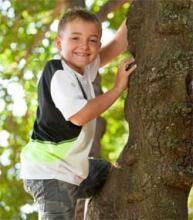
Lower body strength is the ability of the body to exert a maximum force against an object external to the body in one maximum effort of the lower body muscles.1 The muscles that make up the lower body are the large, strong muscles that allow us to get around. The main muscles found below the waist are:
- Quadriceps Femoris, which is a group of four muscles found at the front of the thigh. The role of these muscles is to extend the leg from a bent position.
- Hamstrings are found at the rear of the leg and are used to flex the knee in the act of pulling the heel towards the buttocks.
- Gluteals are muscles that make up the buttocks. Their roles are to facilitate hip extension and lift the leg to the side.
- Hip flexors are found opposite the gluteals on the front of the pelvis, and they raise the leg to the front.
- Calves are the large muscles below the knee that extend the foot at the ankle.2
Children do much to enhance their lower body strength by engaging in daily active play, such as running, jumping, climbing, and bicycling. Maneuvering on playground equipment offers a variety of ways to exercise the lower body muscles and gain strength. There are many types of climbing apparatus, such as rock walls, cargo nets, climbing poles, and ladders to platforms and slides. Pushing merry-go-rounds, balancing on beams, and running and jumping onto swings all take lower body strength.
In the sedentary lifestyle of children today there is little demand for lower body strength as children watch hours of television or play video and computer games.3 The National Association of Sports and Physical Education recommends that school-age children get 60 minutes of moderate to vigorous physical activity every day, divided into several segments of 15 minutes or more, if necessary, and to avoid periods of being inactive for longer than 2 hours.4 Being physically fit offers many benefits, such as, a healthy weight, strong muscles, bones, and joints, decreased risk of developing type 2 diabetes, better sleep, and a feeling of well-being.5
- 1. Gallahue, David L. and Frances Cleland Donnelly. Developmental Physical Education for All Children. 4th ed. Champaign, IL: Human Kinetics. 2003. p. 84.
- 2. Mitchell, Richard. “Know Your Muscles – The Lower Body.” Ezine Articles. < http://ezinearticles.com/?Know-Your-Muscles---The-Lower-Body&id=4430 > 09 Sep. 2010.
- 3. Ibid.
- 4. “Fitness and Your 6-to 12-Year-Old.” KidsHealth from Nemours. < http://kidshealth.org/parent/nutrition_fit/fitness/fitness_6_12.html > 09 Sep. 2010.
- 5. “Motivating Kids to Be Active.” KidsHealth from Nemours. < http://kidshealth.org/parent/nutrition_fit/fitness/active_kids.html > 09 Sep. 2010.

